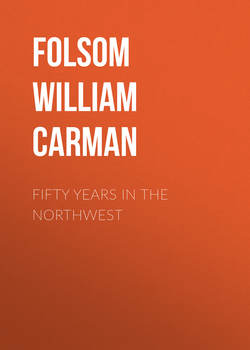Читать книгу Fifty Years In The Northwest - Folsom William Henry Carman - Страница 36
CHAPTER IV.
POLK COUNTY – DESCRIPTION AND HISTORY
INDIAN MURDERS
ОглавлениеIn 1840 Jeremiah Russell, the Indian farmer at Pokegama, Pine county, Minnesota, sent two Chippewa Indians to St. Croix Falls for supplies, who arrived in safety. A band of fifty Sioux Indians were concealed at this (St. Croix Falls) settlement for some days. Within an hour after the arrival of the two Chippewas, the settlement was surrounded by these Sioux. The whites, seeing that trouble was brewing, secreted the Chippewas for two days, the Sioux closely watching. The white men were restless, and afraid to go to work. Capt. Frazer, Rev. Ayers and myself held a council and explained the situation to the Chippewas, who replied that they would not expose the whites to trouble. They resolved on leaving and started in open day north over the trap rock ridge, thence through the bushes, where they discovered two Sioux. The Chippewas were armed and fired on the Sioux, killing them instantly. The Chippewas then started to run. The report of the guns brought squads of Sioux immediately in pursuit, who, firing on the Chippewas, killed one. The two dead Sioux were sons of Little Crow. They were placed by the Sioux in a sitting posture, with backs to a tree, facing the enemy's country, on the second bench near where the mill dam was subsequently built, a double barreled gun standing on the ground between them. They decorated the corpses with war paint, ribbons and mosses. The two Chippewas who killed Little Crow's sons bore the titles Julius and Wezhaymah. The Sioux in pursuit killed Julius, and his head was hung up in a kettle before those he had slain. His body was chopped in pieces and scattered to the four winds.
From an historical letter, written by Mrs. E. T. Ayer, who lives at Belle Prairie, Minnesota, and whom we have elsewhere mentioned, we have the following description of the death of the sons of Little Crow:
"Julius was of medium height, stout build, very neat, and when in full dress very few Indians would favorably compare with him. Being a good hunter he had the means of gratifying his taste. His hair was long and abundant, and was kept clean and shining by the frequent use of comb and brush, with the help of a little marrow or bear's oil. Three or four of his numerous long braids, studded with silver brooches, hung gracefully on both sides of his face and over his arms – the rest of his dress in a manner corresponding. His hair, like Absalom's, did not save him from his enemies. The Dakotas may dance around it for generations and never see its equal.
"Wezhaymah made his appearance at Pokegama. As he drew near the houses he gave a salute from his double barreled gun. The Ojibways were much frightened. They believed the Sioux had returned to make another trial for scalps and plunder. The first impulse of the women was to hide. The chief's wife and oldest daughter being at the mission house, went through a trap door into a dark cellar. But when the supposed dead stood before them, alive and well, there was great rejoicing.
"Wezhaymah said that Julius killed both of Little Crow's sons; that the Sioux followed him but a short distance, then all turned after Julius. He took a circuitous route home, traveling in the night and hiding in the day. Julius' parents, Joseph and Eunice, and other members of their family, were members of the mission church. He and his wife made no profession, though they sometimes attended religious worship."
About twenty days after, about one hundred Sioux came from little Crow's band at Red Rock for the bodies of their dead comrades and the gun, having first, by means of spies, satisfied themselves that there were no Chippewas in the vicinity. One morning, as the whites were going to work, they were surprised by the sudden appearance of these Indians, who rushed suddenly down upon them from different trails, gorgeously painted and without blankets. Their movements were so sudden that the whites were completely surprised, and at the mercy of the Indians, who, however, satisfied themselves with searching the camp and appropriating all the victuals they could find, ostensibly searching for the gun which was not to be found where they had left it. Complaining bitterly of its loss, they withdrew to a trap rock ledge near by, where they formed a circle, danced, sung and fired several guns into the air. They then asked to see "Oge-ma," the agent, and formally demanded the gun. Everyone in camp denied any knowledge whatever of the missing article. The Indians were at first much dissatisfied, but finally Little Crow advanced, smoked a pipe and offered it to. Capt. Frazer, shook hands and withdrew, apparently in peace.
As it is not the custom for Indians to molest the dead, they firmly believed a white man had taken the gun. Little Crow applied to Maj. Plympton at Fort Snelling, charging the theft upon the whites. The major in turn wrote to Capt. Frazer at the Falls to make an investigation, as a result of which the gun was found in a tool chest belonging to Lewis Barlow, concealed under a false bottom. Barlow professed entire innocence and ignorance of the matter, suggesting that his brother must have placed the gun there. Capt. Frazer severely reprimanded him for imperiling the lives of all the whites in the settlement by his foolish and thievish act. The gun was sent to Maj. Plympton, who wrote to Capt. Frazer cautioning him to be on his guard, as the Indians were much irritated. Barlow had earned the contempt and dislike of his fellow workmen.
